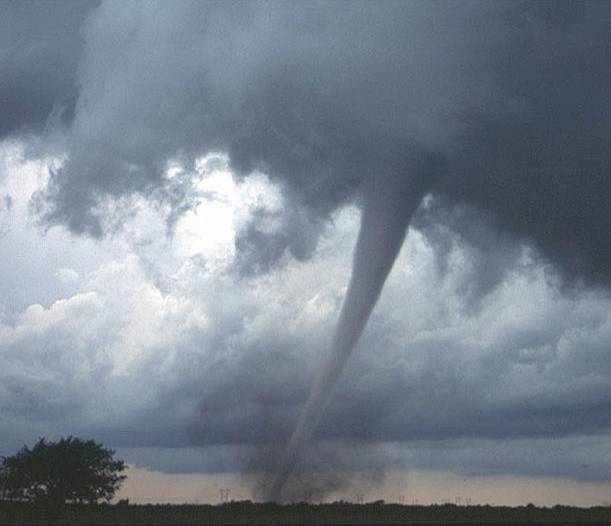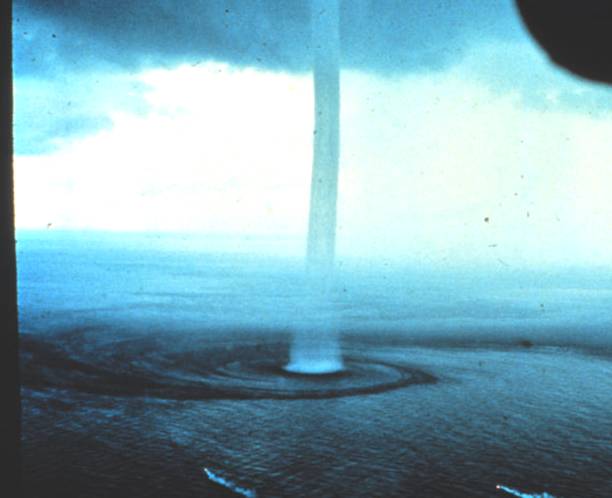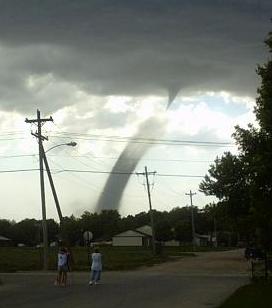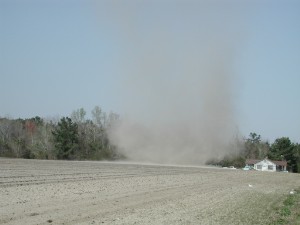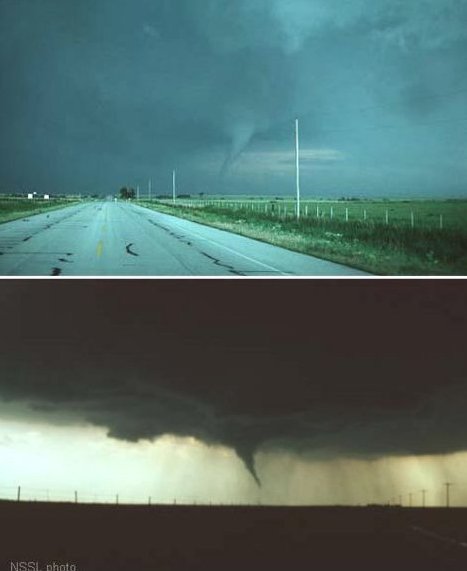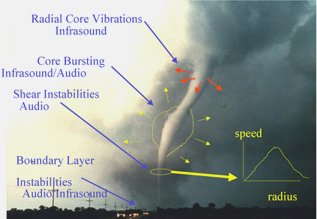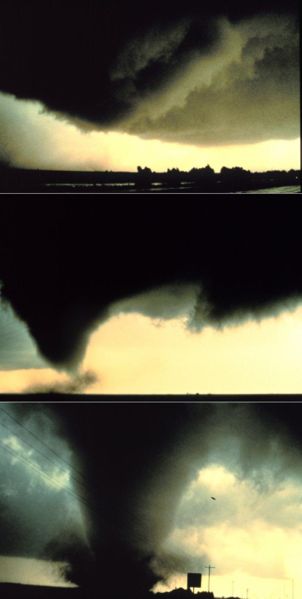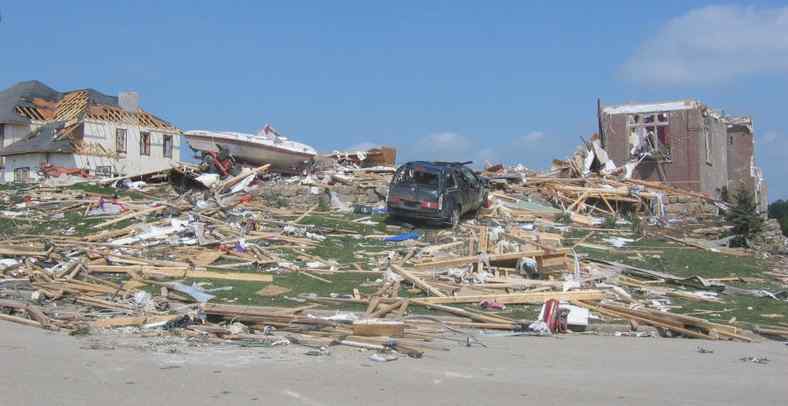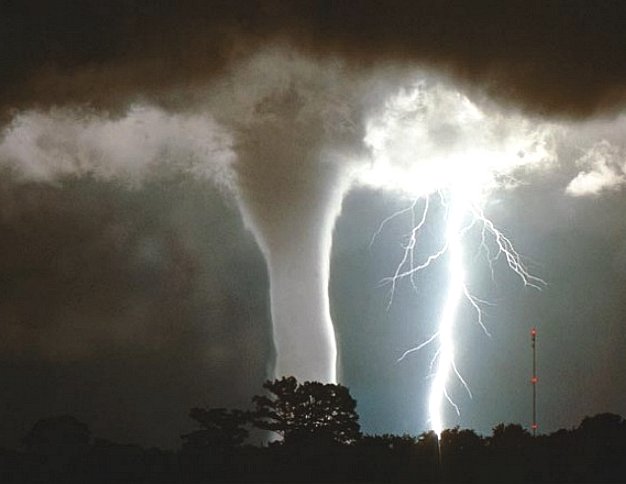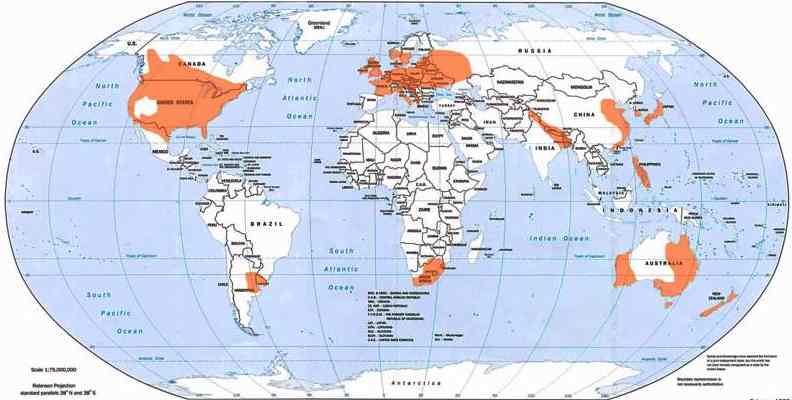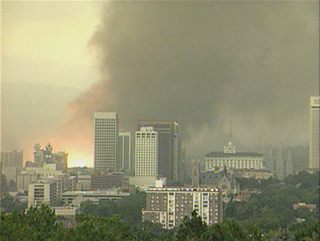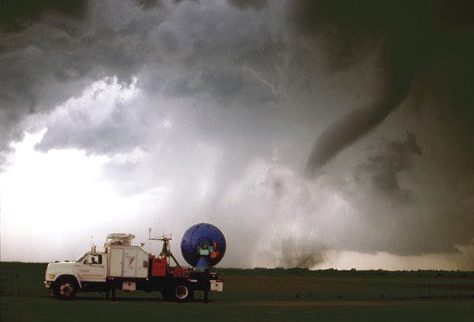|
TORNADOES
|
||||||||
|
HOME | BIOLOGY | BOOKS | FILMS | GEOGRAPHY | HISTORY | INDEX | INVESTORS | MUSIC | NEWS | SOLAR BOATS | SPORT |
||||||||
|
A tornado is a violently rotating column of air which is in contact with both a cumulonimbus (or, in rare cases, a cumulus) cloud base and the surface of the earth. Tornadoes come in many sizes, but are typically in the form of a visible condensation funnel, with the narrow end touching the earth. Often, a cloud of debris encircles the lower portion of the funnel.
Most tornadoes have wind speeds of 110 mph (175 km/h) or less, are approximately 250 feet (75 m) across, and travel a few miles (several kilometers) before dissipating. However, some tornadoes attain wind speeds of more than 300 mph (480 km/h), stretch more than a mile (1.6 km) across, and stay on the ground for dozens of miles (more than 100 km).
A tornado near Oklahoma
Although tornadoes have been observed on every continent except Antarctica, most occur in the United States. Other areas where they commonly occur include south-central Canada, south-central and eastern Asia, east-central South America, Southern Africa, northwestern and central Europe, Italy, western and southeastern Australia, and New Zealand.
Definitions
A tornado is defined by the Glossary of Meteorology as "a violently rotating column of air, in contact with the ground, either pendant from a cumuliform cloud or underneath a cumuliform cloud, and often (but not always) visible as a funnel cloud..."
Condensation funnel
A tornado is not necessarily visible; however, the intense low pressure caused by the high wind speeds (see Bernoulli's principle) and rapid rotation (due to cyclostrophic balance) usually causes water vapor in the air to condense into a visible condensation funnel. Strictly, the term tornado refers to the vortex of wind, not the condensation cloud.
A funnel cloud is a visible condensation funnel with no associated strong winds at the surface. Not all funnel clouds evolve into a tornado. However, many tornadoes are preceded by a funnel cloud as the mesocyclonic rotation descends toward the ground. Most tornadoes produce strong winds at the surface while the visible funnel is still above the ground, so it is difficult to tell the difference between a funnel cloud and a tornado from a distance.
Tornado family
Occasionally a single storm produces multiple tornadoes and mesocyclones. This process is known as cyclic tornadogenesis. Tornadoes produced from the same storm are referred to as a tornado family. Sometimes multiple tornadoes from distinct mesocyclones occur simultaneously.
Tornado outbreak
Occasionally, several tornadoes are spawned from the same large-scale storm system. While there is no single agreed-upon definition, multiple tornadoes spawned by the same storm system with no break in activity is considered a tornado outbreak. A period of several successive days with tornado outbreaks in the same general area (spawned by multiple weather systems) is a tornado outbreak sequence, occasionally called an extended tornado outbreak.
Etymology
The word "tornado" is an altered form of the Spanish word tronada, which means "thunderstorm". This in turn was taken from the Latin tonare, meaning "to thunder". It most likely reached its present form through a combination of the Spanish tronada and tornar ("to turn"); however, this may be a folk etymology. Tornadoes are also commonly referred to as twisters.
A waterspout near the Florida Keys
Types of tornadoes
True tornadoes
Multiple vortex tornado
A multiple vortex tornado is a type of tornado in which two or more columns of spinning air rotate around a common center. Multivortex structure can occur in almost any circulation, however it is very often observed in intense tornadoes.
Satellite tornado
A satellite tornado is a term for a weaker tornado which forms very near a large, strong tornado contained within the same mesocyclone. The satellite tornado may appear to "orbit" the larger tornado (hence the name), giving the appearance of one, large multi-vortex tornado. However, a satellite tornado is a distinct funnel, and is much smaller than the main funnel.
Waterspout
A waterspout is officially defined by the U.S. National Weather Service simply as a tornado over water. Amongst researchers, however, they are typically divided into two categories: "fair weather" waterspouts, and tornadic waterspouts.
A landspout near North Platte, Nebraska on May 22, 2004
Landspout
A landspout is an unofficial term for a tornado not associated with a mesocyclone. The name stems from their characterization as essentially a "fair weather waterspout on land". They share most of the characteristics with their water-based brethren, including relative weakness, short lifespan, and a small, smooth condensation funnel which often does not reach the ground. Landspouts also create a distinctively laminar cloud of dust when they make contact with the ground, owing to their differing mechanics from true mesoform tornadoes. Though usually weaker than classic tornadoes, they still possess strong winds and can cause serious damage.
Tornado-like circulations
Gustnado
A gustnado (gust front tornado) is a small, vertical swirl associated with a gust front or downburst. Because they are technically not associated with the cloud base, there is some debate as to whether or not gustnadoes are actually tornadoes. They are formed when fast moving cold, dry outflow air from a thunderstorm is blown through a mass of stationary, warm, moist air near the outflow boundary, resulting in a "rolling" effect (often exemplified through a roll cloud). If low level wind shear is strong enough, the rotation can be turned horizontally (or diagonally) and make contact with the ground. The result is a gustnado. They usually cause small areas of heavier rotational wind damage among areas of straight-line wind damage. It is also worth noting that since they are absent of any Coriolis influence from a mesocyclone, they seem to be alternately cyclonic and anticyclonic without preference.
Dust devil
A dust devil resembles a tornado in that it is a vertical swirling column of air. However, they form under clear skies and are rarely as strong as even the weakest tornadoes. They form when a strong convective updraft is formed near the ground on a hot day. If there is enough low level wind shear, the column of hot, rising air can develop a small cyclonic motion that can be seen near the ground. They are not considered tornadoes because they form during fair weather and are not associated with any actual cloud. However, they can, on occasion, result in major damage and fatalities, especially in arid areas.
Fire whirl
Tornado-like circulations occasionally occur near large, intense wildfires and are called fire whirls. They are not considered tornadoes except in the rare case where they connect to a pyrocumulus or other cumuliform cloud above. Fire whirls usually are not as strong as tornadoes associated with thunderstorms. However, they can produce significant damage. Cold air vortex
A cold air vortex or shear funnel is a tiny, harmless funnel cloud which occasionally forms underneath or on the sides of normal cumuliform clouds, rarely causing any winds at ground-level. Their genesis and mechanics are poorly understood, as they are quite rare, short lived, and hard to spot (due to their non-rotational nature and small size).
Dust devil in Johnsonville, South Carolina
Characteristics
Shape
Most tornadoes take on the appearance of a narrow funnel, a few hundred yards (a few hundred meters) across, with a small cloud of debris near the ground. However, tornadoes can appear in many shapes and sizes.
Small, relatively weak landspouts may only be visible as a small swirl of dust on the ground. While the condensation funnel may not extend all the way to the ground, if associated surface winds are greater than 40 mph (64 km/h), the circulation is considered a tornado. Large single-vortex tornadoes can look like large wedges stuck into the ground, and so are known as wedge tornadoes or wedges. A wedge can be so wide that it appears to be a block of dark clouds. Even experienced storm observers may not be able to tell the difference between a low-hanging cloud and a wedge tornado from a distance.
Tornadoes in the dissipating stage can resemble narrow tubes or ropes, and often curl or twist into complex shapes. These tornadoes are said to be roping out, or becoming a rope tornado. Multiple-vortex tornadoes can appear as a family of swirls circling a common center, or may be completely obscured by condensation, dust, and debris, appearing to be a single funnel.
In addition to these appearances, tornadoes may be obscured completely by rain or dust. These tornadoes are especially dangerous, as even experienced meteorologists might not spot them.
Size
In the United States, an average tornado is around 500 feet (150 m) across, and stays on the ground for 5 miles (8 km). While this is the average, there is an extremely wide range of tornado sizes, even for typical tornadoes. Weak tornadoes, or strong but dissipating tornadoes, can be exceedingly narrow, sometimes only a few feet across. In fact, a tornado was once reported to have a damage path only 7 feet (2 m) long. On the other end of the spectrum, wedge tornadoes can have a damage path a mile (1.6 km) wide or more. A tornado that affected Hallam, Nebraska on May 22, 2004 was at one point 2.5 miles (4 km) wide at the ground.
In terms of path length, the Tri-State Tornado, which affected parts of Missouri, Illinois, and Indiana on March 18, 1925, was officially on the ground continuously for 219 miles (352 km). Many tornadoes which appear to have path lengths of 100 miles or longer are actually a family of tornadoes which have formed in quick succession; however, there is no substantial evidence that this occurred in the case of the Tri-State Tornado. In fact, modern reanalysis of the path suggests that the tornado began 15 miles (24 km) further west than previously thought.
Appearance
Tornadoes, depending on the environment in which they form, can have a wide range of colors. Tornadoes which form in a dry environment can be nearly invisible, marked only by swirling debris at the base of the funnel. Condensation funnels which pick up little or no debris can be gray to white. While travelling over a body of water as a waterspout, they can turn very white or even blue. Funnels which move slowly, ingesting a lot of debris and dirt, are usually darker, taking on the color of debris. Tornadoes in the Great Plains can turn red because of the reddish tint of the soil, and tornadoes in mountainous areas can travel over snow-covered ground, turning brilliantly white in the process.
Two photographs of the Waurika, Oklahoma tornado of May 30, 1976, taken at nearly the same time by two different photographers. In the top picture, the tornado is front-lit, with the sun behind the east-facing camera, so the funnel appears nearly white. In the lower image, where the camera is facing the opposite direction, the tornado is back-lit, with the sun behind the clouds
Lighting conditions are also a major factor in the appearance of a tornado. A tornado which is "back-lit", or viewed with the sun behind it, will appear to be very dark. The same tornado, viewed with the sun at the observer's back, may appear gray or brilliant white. Tornadoes which occur near the time of sunset can be many different colors, appearing in hues of yellow, orange, and pink.
Dust kicked up by the winds of the parent thunderstorm, heavy rain and hail, and the darkness of night are all factors which can reduce the visibility of tornadoes, making them "invisible", in essence. Tornadoes occurring in these conditions are especially dangerous, since only radar observations, or possibly the sound of an approaching tornado, serve as any warning to those in the storm's path. Fortunately most significant tornadoes form under the storm's rain-free base, or the area under the thunderstorm's updraft, where there is little or no rain. In addition, most tornadoes occur in the late afternoon, when the bright sun can penetrate even the thickest clouds. Also, night-time tornadoes are often illuminated by frequent lightning. There is mounting evidence, including DOW mobile radar images and eyewitness accounts, which suggest that most tornadoes have a clear, calm center with extremely low pressure, akin to the eye found in tropical cyclones. This area would be clear (possibly full of dust), have relatively light winds, and be very dark, with the light blocked out by swirling debris on the outside of the tornado. Lightning is said to be the source of illumination for those who claim to have seen the interior of a tornado.
Rotation
Tornadoes normally rotate cyclonically in direction (counterclockwise in the northern hemisphere, clockwise in the southern). While large-scale storms always rotate cyclonically due to the Coriolis effect, thunderstorms and tornadoes are so small that the direct influence of Coriolis effect is inconsequential, as demonstrated physically by the Rossby number. Supercells and tornadoes would rotate cyclonically even without the Coriolis effect, as evidenced by their doing so in numerical simulations which neglect the Coriolis component. Low-level mesocyclones and tornadoes owe their rotation to complex processes within the supercell and ambient environment.
Approximately 1% of tornadoes rotate in an anticyclonic direction. Typically, only landspouts and gustnados rotate anticyclonically, and usually only those which form on the anticyclonic shear side of the descending RFD in a cyclonic supercell. However, on rare occasions, anticyclonic tornadoes form in association with the mesoanticyclone of an anticyclonic supercell, in the same manner as the typical cyclonic tornado, or as a companion tornado—either or a satellite tornado or associated with anticyclonic eddies within a supercell.
Sound and seismology
Tornadoes emit widely on the acoustics spectrum and multiple mechanisms cause the sound of a tornado. Various sounds of tornadoes have been reported throughout time, mostly related to familiar sounds for the earwitness and generally some variation of a whooshing roar. Among the popularly reported sounds are a freight train, rushing rapids or a waterfall, and a jet engine from close proximity, or combinations thereof. Many tornadoes are not audible from much distance; the nature and propagation distance of the audible sound depends on atmospheric conditions and topography.
The winds of both the tornado vortex and constituent turbulent eddies, as well as airflow interaction with the surface and debris, contribute to the sound of a tornado; this is evidenced by both funnel clouds and tornadoes having sounds, and the associated sounds differing. Funnel clouds and small tornadoes are reported as a whistling, whining, humming, or the buzzing of innumerable bees or electricity, or more or less harmonic, whereas many tornadoes are reported as a continuous, deep rumbling, or an irregular sound of “noise”. It is important to note that many tornadoes do not produce any sound unless one is within very close proximity, so sound is not reliable forewarning of a tornado; and that not only tornadoes but also any strong, damaging wind, even a severe hail volley or continuous thunder within a thunderstorm may produce a roaring sound.
Illustration of generation of infrasound in tornadoes by the Earth System Research Laboratory's Infrasound Program
In addition to the audible spectrum, tornadoes also produce identifiable infrasonic signatures. Unlike audible signatures, tornadic signatures have been isolated; due to the long distance propagation of low-frequency sound, efforts are ongoing in developing tornado prediction and detection devices with additional value in understanding tornado morphology, dynamics, and tornadogenesis. Tornadoes also produce a detectable seismic signature, although research continues on isolating the signature and understanding the process.
Electromagnetic, lightning, and other effects
Tornadoes emit on the electromagnetic spectrum, for example, with sferics and E-field effects detected. The effects vary, mostly with little observed consistency. Luminosity has been reported in the past, and is probably due to misidentification of external light sources such as lightning, city lights, and power flashes from broken lines, as internal sources are now uncommonly reported and are not known to ever been recorded. Correlations with patterns of lightning activity have also been observed, however, no consistent correlations have been advanced. Electromagnetics and lightning have little to nothing to do directly with what drives tornadoes (tornadoes are basically a thermodynamic phenomenon), though there are likely connections with the storm and environment affecting both phenomena.
In addition to winds, tornadoes also exhibit changes in atmospheric variables such as temperature, moisture, and pressure; for example, in June 2004, a probe measured a 100 mb (hPa) (2.95 inHg) pressure drop.
Sequence of images showing the birth of a tornado. First, the rotating cloud base lowers. This lowering becomes a funnel, which continues descending while winds build near the surface, kicking up dust and other debris. Finally, the visible funnel extends to the ground, and the tornado begins causing major damage. This tornado, near Dimmitt, Texas, was one of the best-observed violent tornadoes in history
Life cycle
Supercell relationship
Tornadoes often develop from a class of thunderstorms known as supercells. Supercells contain mesocyclones, an area of organized rotation a few miles up in the atmosphere, usually 1–6 miles (2–10 km) across. Most intense tornadoes (EF3 to EF5 on the Enhanced Fujita Scale) develop from supercells. In addition to tornadoes, very heavy rain, frequent lightning, strong wind gusts, and hail are common in such storms.
Most tornadoes from supercells follow a recognizable life cycle. The cycle begins when increasing rainfall drags with it an area of quickly descending air known as the rear flank downdraft (RFD). This downdraft accelerates as it approaches the ground, and drags the supercell's rotating mesocyclone towards the ground with it.
Tornado formation
As the mesocyclone approaches the ground, a visible condensation funnel appears to descend from the base of the storm, often from a rotating wall cloud. As the funnel descends, the RFD also reaches the ground, creating a gust front that can cause damage a good distance from the tornado. Usually, the funnel cloud becomes a tornado within minutes of the RFD reaching the ground.
Initially, the tornado has a good source of warm, moist inflow to power it, so it grows until it reaches the mature stage. During its mature stage, which can last anywhere from a few minutes to more than an hour, a tornado often causes the most damage, and can in rare instances be more than one mile across. Meanwhile, the RFD, now an area of cool surface winds, begins to wrap around the tornado, cutting off the inflow of warm air which feeds the tornado.
Maturity and demise
As the RFD completely wraps around and chokes off the tornado's air supply, the vortex begins to weaken, becoming thin and rope-like. This is the dissipating stage; often lasting no more than a few minutes, after which the tornado fizzles. During the dissipating stage the shape of the tornado becomes highly influenced by the winds of the parent storm, and can be blown into fantastic patterns.
As the tornado enters the dissipating stage, its associated mesocyclone often weakens as well, as the rear flank downdraft cuts off the inflow powering it. In particularly intense supercells tornadoes can develop cyclically. As the first mesocyclone and associated tornado dissipate, the storm's inflow may be concentrated into a new area closer to the center of the storm. If a new mesocyclone develops, the cycle may start again, producing one or more new tornadoes. Occasionally, the old (occluded) mesocyclone and the new mesocyclone produce a tornado at the same time.
Though this is a widely-accepted theory for how most tornadoes form, live, and die, it does not explain the formation of smaller tornadoes, such as landspouts, long-lived tornadoes, or tornadoes with multiple vortices. These each have different mechanisms which influence their development—however, most tornadoes follow a pattern similar to this one.
Example of EF3 damage - roof and some inner walls of brick building have been demolished
Intensity and damage
The Fujita scale and the Enhanced Fujita Scale rate tornadoes by damage caused. The Enhanced Fujita Scale was an upgrade to the older Fujita scale, with engineered (by expert elicitation) wind estimates and better damage descriptions, but was designed so that a tornado rated on the Fujita scale would receive the same numerical rating. An EF0 tornado will likely damage trees but not substantial structures, whereas an EF5 tornado can rip buildings off their foundations leaving them bare and even deform large skyscrapers. The similar TORRO scale ranges from a T0 for extremely weak tornadoes to T11 for the most powerful known tornadoes. Radar data, photogrammetry, and ground swirl patterns (cycloidal marks) may also be analyzed to determine intensity and award a rating.
Tornadoes vary in intensity regardless of shape, size, and location, though strong tornadoes are typically larger than weak tornadoes. The association with track length and duration also varies, although longer track tornadoes tend to be stronger. In the case of violent tornadoes, only a small portion of the path is of violent intensity, most of the higher intensity from subvortices.
In the United States, EF0 and EF1 (T0 through T3) tornadoes account for 80% of all tornadoes. The rate of occurrence drops off quickly with increasing strength—violent tornadoes (stronger than EF4, T8), account for less than 1% of all tornado reports. Outside of the United States, areas in south-central Asia, and perhaps portions of southeastern South America and southern Africa, violent tornadoes are extremely rare. This is apparently mostly due to the lesser number of tornadoes overall, however, as research has found that tornado intensity distributions are fairly similar worldwide. A few significant tornadoes occur annually in Europe, Asia, southern Africa, and southeastern South America, respectively.
Climatology
The United States has the most tornadoes of any country, seeing about four times the activity estimated in all of Europe (not including waterspouts). This is mostly due to the unique geography of the continent. North America is a relatively large continent that extends from the tropical south into arctic areas, and has no major east-west mountain range to block air flow between these two areas. In the middle latitudes, where most tornadoes of the world occur, the Rocky Mountains block moisture and atmospheric flow, allowing drier air at mid-levels of the troposphere, and causing cyclogenesis downstream to the east of the mountains. The desert Southwest also feeds drier air and the dry line, while the Gulf of Mexico fuels abundant low-level moisture. This unique topography allows for many collisions of warm and cold air; creating the conditions necessary to breed strong, long-lived storms which occur many times a year. A large portion of these tornadoes form in an area of the central United States known as Tornado Alley. This area extends into Canada, particularly Ontario and the Prairie Provinces. Strong tornadoes also occasionally occur in northern Mexico.
The United States averages about 1,200 tornadoes per year. The Netherlands has the highest average number of recorded tornadoes per area of any country (more than 20, or 0.0013 per sq mi (0.00048 per km²), annually), followed by the UK (around 33, or 0.00035 per sq mi (0.00013 per km²), per year), but most are small and result in minor damage. In absolute number of events, ignoring area, the UK experiences more tornadoes than any other European country, excluding waterspouts.
Bangladesh and surrounding areas of eastern India suffer from tornadoes of equal severity to those in the US with more regularity than any other region in the world, however these tend to be under-reported due to the scarcity of media coverage in third-world countries. The annual human death toll is about 179 deaths per year from tornadoes in Bangladesh, which is much greater than in the US. This is likely due to the density of population, poor quality of construction, lack of tornado safety knowledge, and other factors. Other areas of the world that have more frequent tornadoes include South Africa, parts of Argentina, Paraguay, and southern Brazil, as well as portions of Europe, Australia and New Zealand, and far eastern Asia.
Tornadoes can form in any month, providing the conditions are favorable. They are least common during the winter and most common in spring. Since autumn and spring are transitional periods (warm to cool and vice versa) there are more chances of cooler air meeting with warmer air, resulting in thunderstorms. Tornadoes can also be caused by landfalling tropical cyclones, which tend to occur in the late summer and fall.
Tornado occurrence is highly dependent on the time of day, because of solar heating. Worldwide, most tornadoes occur in the late afternoon, between the hours of 3 and 7 pm local time, with a peak near 5 pm. However, destructive tornadoes can occur at any time of day. The Gainesville Tornado of 1936, one of the deadliest tornadoes in history, occurred at 8:30 am local time.
Prediction
Weather forecasting is handled regionally by many national and international agencies. For the most part, they are also in charge of the prediction of conditions conducive to tornado development.
Australia
Severe thunderstorm warnings are provided to Australia by the Bureau of Meteorology. The country is in the middle of an upgrade to Doppler radar systems, with their first benchmark of installing six new radars reached in July 2006.
Europe
The European Union founded a project in 2002 called the European Severe Storms virtual Laboratory, or ESSL, which is meant to fully document tornado occurrence across the continent. The ESTOFEX (European Storm Forecast Experiment) arm of the project also issues one day forecasts for severe weather likelihood. In Germany, Austria, and Switzerland, an organization known as TorDACH collects information regarding tornadoes, waterspouts, and downbursts from Germany, Austria, and Switzerland. A secondary goal is collect all severe weather information. This project is meant to fully document severe weather activity in these three countries.
United Kingdom
In the United Kingdom, the Tornado and Storm Research Organisation (TORRO) makes experimental predictions. The Met Office provides official forecasts for the UK.
United States
In the United States, generalized severe weather predictions are issued by the Storm Prediction Center, based in Norman, Oklahoma. For the next one, two, and three days, respectively, they will issue categorical and probabilistic forecasts of severe weather, including tornadoes. There is also a more general forecast issued for the four to eight day period. Just prior to the expected onset of an organized severe weather threat, SPC issues severe thunderstorm and tornado watches, in collaboration with local National Weather Service offices. Warnings are issued by local National Weather Service offices when a severe thunderstorm or tornado is occurring or imminent.
Other areas
In Japan, predictions and study of tornadoes in Japan are handled by the Japan Meteorological Agency. In Canada, weather forecasts and warnings, including tornadoes, are produced by the Meteorological Service of Canada, a division of Environment Canada.
Detection
Rigorous attempts to give warning for tornadoes began in the United States in the middle of the 20th century. Before the 1950s, the only method of detecting a tornado was by someone seeing it on the ground. Often, news of a tornado would not reach the local Weather Bureau Office until after the storm was over. However, with the advent of weather radar, areas near a local office could get advance warning of severe weather. With the confirmation that hook echos are indeed associated with tornadoes in 1953, meteorologists gained the ability to detect thunderstorms likely producing tornadoes from dozens of miles away by recognizing the radar signatures associated with many tornadoes.
In the mid 1970s, the US National Weather Service began increased efforts to train Skywarn spotters, consisting of local sheriff's deputies, state troopers, firefighters, amateur radio operators, civil defense (now emergency management) spotters, storm chasers, and ordinary citizens, to spot key features of storms which indicate severe hail, strong winds, and tornadoes. When severe weather is anticipated, local weather service offices request that these spotters be on the lookout for severe weather, and report any possible tornadoes immediately, so the office can issue a timely warning. There are currently more than 230,000 trained Skywarn weather spotters across the United States. In Canada, Canwarn, a similar network of Volunteer Weather Watchers now exists to help spot severe weather, with more than 1,000 volunteers. In Europe, several nations are organizing spotter networks under the auspices of Skywarn Europe and the Tornado and Storm Research Organisation (TORRO) has maintained a network of spotters in the United Kingdom since the 1970s.
Today, most developed countries have a network of weather radars, which remains the main method of detecting signatures likely associated with tornadoes. In the United States and a few other countries, Doppler weather radar stations are used as the main detection method for tornadic thunderstorms. These devices are capable of measuring the velocity and radial direction (towards or away from the radar) of the winds in a storm, and so can spot evidence of rotation in storms from more than a hundred miles away. Additionally, most populated areas of the earth are now visible from the Geostationary Operational Environmental Satellites (GOES), which aid in the detection of tornadic storms.
Areas worldwide where tornadoes are most likely, indicated by orange shading
Extremes
In terms of the most extreme tornado in recorded history, the honor undoubtedly goes to the Tri-State Tornado which roared through parts of Missouri, Illinois, and Indiana on March 18, 1925. This tornado, likely an F5 (though this was before the era where tornadoes were ranked on any damage scale), set (and still holds) records for the deadliest single United States tornado (695 dead), longest path length (219 miles, 352 km), longest duration (about 3.5 hours), and fastest forward speed for a significant tornado (73 mph, 117 km/h). It was also the second costliest tornado in history at the time, but has since been surpassed by several others non-normalized, it still ranks third when normalized for wealth and inflation.
The deadliest tornado in world history occurred in Bangladesh on April 26, 1989, killing approximately 1300 people.
The most extensive tornado outbreak on record, in almost every category, was the Super Outbreak, which affected a large area of the Central United States and extreme southern Ontario in Canada on April 3 and April 4, 1974. Not only did this outbreak feature an incredible 148 tornadoes in only 18 hours, but an unprecedented amount of them were violent; six of the tornadoes were of F5 intensity, and 24 were of F4 intensity. More than 300 people, possibly as many as 330, were killed by tornadoes during this outbreak.
While it is nearly impossible to directly measure the most violent tornado wind speeds (conventional anemometers would be destroyed by the intense winds), some tornadoes have been scanned by mobile Doppler radar units, which can provide a good estimate of the tornado's winds. The highest wind speed ever measured in a tornado, which is also the highest wind speed ever recorded on the planet, is 301 ± 20 mph (484 ± 32 km/h) in the F5 Moore, Oklahoma tornado. Though the reading was taken about 100 feet (30 m) above the ground, this is a testament to the power of the strongest tornadoes.
Storms which produce tornadoes can feature intense updrafts (sometimes exceeding 150 mph, 240 km/h). As such, debris from a tornado can be lofted into the parent storm, and be carried for very long distances. A tornado which affected Great Bend, Kansas in November, 1915 was an extreme case, where a "rain of debris" occurred 80 miles (130 km) from the town, a sack of flour was found 110 miles (177 km) away, and a cancelled check from the Great Bend bank was found in a field outside of Palmyra, Nebraska, 305 miles (491 km) to the northeast.
Safety
Though tornadoes can strike in an instant, there are precautions and preventative measures that people can take to increase the chances of surviving a tornado. Authorities such as the Storm Prediction Center advise having a tornado plan. When a tornado warning is issued, going to a basement or an interior first-floor room of a sturdy building greatly increases chances of survival. In tornado-prone areas, many buildings have storm cellars on the property. These underground refuges have saved thousands of lives.
Some countries have meteorological agencies which distribute tornado forecasts and increase levels of alert of a possible tornado (such as tornado watches and warnings in the United States and Canada). Weather radios provide an alarm when a severe weather advisory is issued for the local area, though these are mainly available only in the United States.
Unless the tornado is far away and highly visible, meteorologists advise that drivers park their vehicles far to the side of the road (so as not to block emergency traffic), and find a sturdy shelter. If no sturdy shelter is nearby, getting low in a ditch is the next best option. Highway overpasses are extremely bad shelter during tornadoes (see next section).
Salt Lake City Tornado, August 11, 1999. This tornado disproved several myths, including the idea that tornadoes cannot occur in areas like Utah
Myths and misconceptions
One of the most persistent myths associated with tornadoes is that opening windows will lessen the damage caused by the tornado. While there is a large drop in atmospheric pressure inside a strong tornado, it is unlikely that the pressure drop would be enough to cause the house to explode. Some research indicates that opening windows may actually increase the severity of the tornado's damage. Regardless of the validity of the explosion claim, time would be better spent seeking shelter before a tornado than opening windows. A violent tornado can destroy a house whether its windows are open or closed.
Another commonly held belief is that highway overpasses provide adequate shelter from tornadoes. On the contrary, a highway overpass is a dangerous place during a tornado. In the Oklahoma Tornado Outbreak of May 3, 1999, three highway overpasses were directly struck by tornadoes, and at all three locations there was a fatality, along with many life-threatening injuries. The small area under the overpasses created a kind of wind tunnel, increasing the wind's speed, making the situation worse. By comparison, during the same tornado outbreak, more than 2000 homes were completely destroyed, with another 7000 damaged, and yet only a few dozen people died in their homes.
An old belief is that the southwest corner of a basement provides the most protection during a tornado. The safest place is the side or corner of an underground room opposite the tornado's direction of approach (usually the northeast corner), or the central-most room on the lowest floor. Taking shelter under a sturdy table, in a basement, or under a staircase increases chances of survival even more.
Finally, there are areas which people believe to be protected from tornadoes, whether by a major river, a hill or mountain, or even protected by "spirits". Tornadoes have been known to cross major rivers, climb mountains, and affect valleys. As a general rule, no area is "safe" from tornadoes, though some areas are more susceptible than others.
Continuing research
Meteorology is a relatively young science and the study of tornadoes even more so. Although studied for about 140 years and intensively for around 60 years, there are still aspects of tornadoes which remain a mystery. Scientists do have a fairly good idea of the development of thunderstorms and mesocyclones, and the meteorological conditions conducive to their formation; however, the step from supercell (or other respective formative processes) to tornadogenesis and predicting tornadic vs. non-tornadic mesocyclones is not yet well understood and is the focus of much research.
Also under study are the low-level mesocyclone and the stretching of low-level vorticity which tightens into a tornado, namely, what are the processes and what is the relationship of the environment and the convective storm. Intense tornadoes have been observed forming simultaneously with a mesocyclone aloft (rather than succeeding mesocyclogenesis) and some intense tornadoes have occurred without a mid-level mesocyclone. In particular, the role of downdrafts, particularly the rear-flank downdraft, and the role of baroclinic boundaries, are intense areas of study.
Reliably predicting tornado intensity and longevity remains a problem, as do details affecting characteristics of a tornado during its life cycle and tornadolysis. Other rich areas of research are tornadoes associated with mesovortices within linear thunderstorm structures and within tropical cyclones.
Scientists still do not know the exact mechanisms by which most tornadoes form, and occasional tornadoes still strike without a tornado warning being issued, especially in under-developed countries. Analysis of observations including both stationary and mobile (surface and aerial) in-situ and remote sensing (passive and active) instruments generates new ideas and refines existing notions. Numerical modeling also provides new insights as observations and new discoveries are integrated into our physical understanding and then tested in computer simulations which validate new notions as well as produce entirely new theoretical findings, many of which are otherwise unattainable. Importantly, development of new observation technologies and installation of finer spatial and temporal resolution observation networks have aided increased understanding and better predictions.
Research programs, including field projects such as VORTEX, deployment of TOTO (the TOtable Tornado Observatory), Doppler On Wheels (DOW), and dozens of other programs, hope to solve many questions that still plague meteorologists. Universities, government agencies such as the National Severe Storms Laboratory, private-sector meteorologists, and the National Center for Atmospheric Research are some of the organizations very active in research; with various sources of funding, both private and public, a chief entity being the National Science Foundation.
A Doppler On Wheels unit observing a tornado near Attica, Kansas
LINKS and REFERENCE
New energy drinks for performers .. Thirst for Life
330ml Earth can - the World in Your Hands
|
||||||||
|
This website is Copyright © 1999 & 2012 Max Energy Limited, an educational charity working for world peace. The bird logos and names Blueplanet Ecostar, Solar Navigator and Utopia Tristar are trademarks. All rights reserved. |
||||||||
|
AUTOMOTIVE | BLUEPLANET | ELECTRIC CARS | ELECTRIC CYCLES | SOLAR CARS | SOLARNAVIGATOR | UTOPIA |
